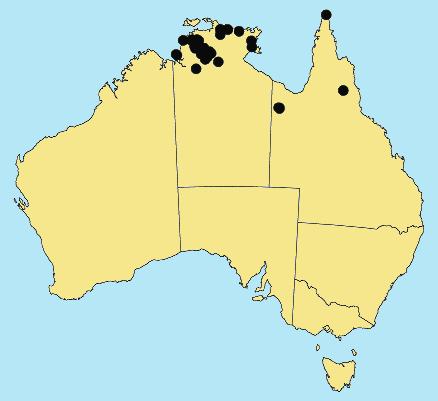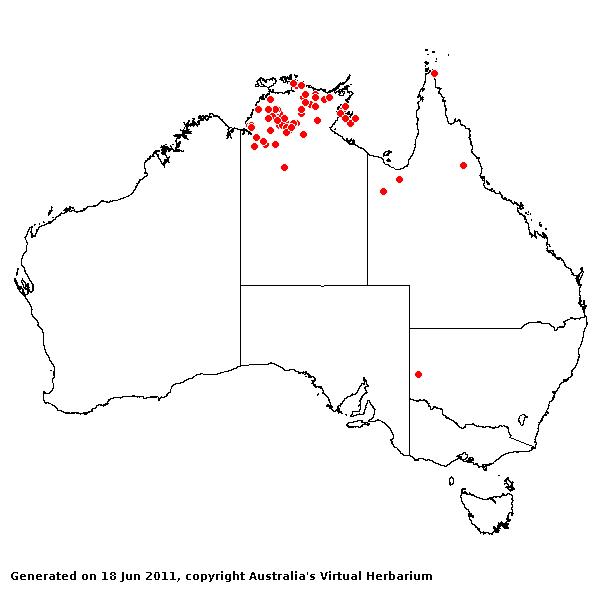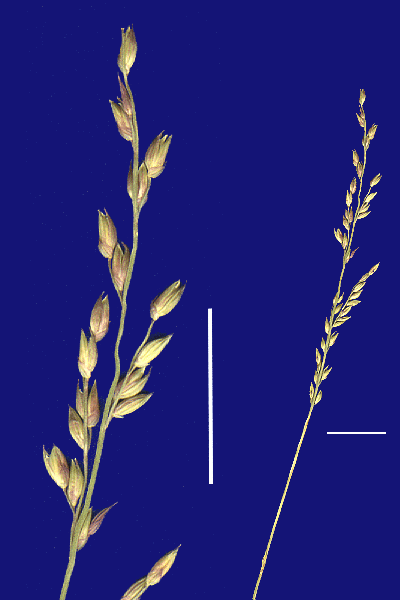Whiteochloa semitonsa (F.Muell. ex
Benth.) C.E.Hubb. Austrobaileya 2: 23 (1984).
Classification. (GPWG 2001) : Subfamily Panicoideae. Paniceae.
Basionym and/or
Replacement Name: Panicum
semitonsum F. Muell. ex Benth., Fl. Austral. 7: 483 (1878).
Type of Basionym or
Protologue Information: LT: Elsey s.n., Australia:
Northern Territory: Darwin & Gulf Distr., Victoria River (K). LT designated by Hughes, Kew
Bull. 9:30 (1923).
Key references
(books and floras): [1878] G.Bentham, Flora Australiensis 7 (483 as Panicum
semitonsum), [2002] D.Sharp & B.K.Simon, AusGrass, Grasses of Australia.
Derivation:
from the Latin semi- (half) and tonsa (shaven). Origin unclear,
not given by author.
Habit. Annual.
Culms 30–60 cm tall, 3–6 -noded. Mid-culm nodes glabrous or pubescent. Leaf-sheaths
glabrous on surface or hairy. Ligule a fringe of hairs, 0.5 mm long.
Leaf-blades flat or conduplicate, 6–11(–23) cm long, 3–4(–5) mm wide.
Leaf-blade surface scabrous, glabrous or indumented.
Inflorescence.
Inflorescence compound, a panicle of racemes. Racemes 7–12, (2–)3–5(–8.5) cm
long, bearing 8–32 fertile spikelets on each. Central inflorescence axis 8–14
cm long.
Spikelets.
Spikelets pedicelled, 2 in the cluster. Fertile spikelets 2-flowered, the lower
floret barren (rarely male), the upper fertile, comprising 1 basal sterile
florets, comprising 1 fertile floret(s), without rachilla extension, elliptic,
laterally compressed, 2.5–3(–3.75) mm long. Rhachilla internodes brief up to
lowest fertile floret, or elongated below proximal fertile floret (0.1mm).
Glumes.
Glumes dissimilar, thinner than fertile lemma. Lower glume oblate, membranous,
without keels, 3–5 -nerved. Lower glume surface glabrous or indumented. Lower
glume apex muticous or mucronate. Upper glume oblong, 2.5–3.4 mm long, membranous,
without keels, 5–7 -nerved. Upper glume surface smooth or tuberculate, glabrous
or indumented. Upper glume apex mucronate. Florets. Basal sterile
florets 1, male or barren, with palea. Lemma of lower sterile floret 100 % of
length of spikelet, scarious, 5 -nerved, muticous.
Fertile lemma 1.7–2.5
mm long, without keel. Lemma apex mucronate. Grain 1.5–1.75 mm long.
Continental
Distribution: Australasia.
Australian
Distribution: Northern Territory, Queensland.
Northern Territory: Darwin &
Gulf. Queensland:
Cook, Burke.
Notes.
Diagnostic features of W. semitonsa include the racemose primary
branches, short pedicels, usually hairy (strigose) upper glume, usually
glabrous culm nodes and overlapping spikelets. The lemma of the lower floret
has a distinct vertical groove and a hyaline area at the base. At maturity, the
lemma splits along this groove exposing the well developed stamens of the lower
floret and facilitates dispersal of the mature pollen.
In tropical and
subtropical sub-humid woodlands. Flowers Feb.-July.




